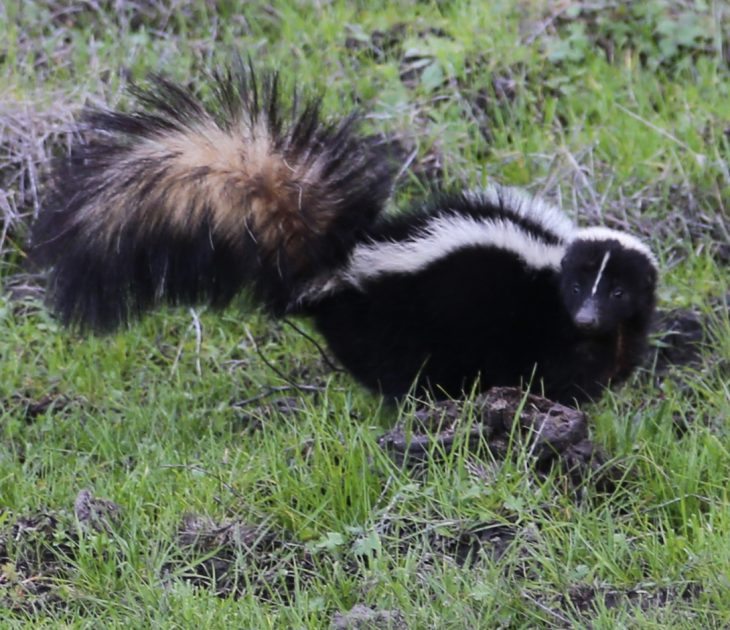
Behind a Skunk in the Road: Where did the Words Come From?
Dynestee Fields
As I commuted from Central this sunlit afternoon, my eyes strayed to the medium of the highway to where a black and white figure lay stretched vastly beyond its original proportions. I sighed, driving along at the rate of the traffic around me. Another skunk had fallen victim to the treacherous interstate.
Reflecting back on that skunk’s tragic demise, I wonder how it received its name. Was it the original moniker that Adam bestowed upon his or her species at the dawn of time, or had some later people group seen the creature and blurted out the first word that came to mind? If so, had it been the Native Americans, the British settlers, or the Spanish? My musing carries on aimlessly until I am ready to end the whole thing. I stand up and gather a book and my laptop. The resources needed to provide a thorough answer to my inquiry.
According to Melvyn Bragg, author of The Adventure of English, the English settlers who arrived on the Mayflower and ships like it “found new plants, new animals, new geographical features, and they needed new words to describe them” when they reached their destination (Bragg). To fill this deficit, they both created new words and borrowed others from the Native Americans. Several of the words that the settlers coined include “foothill,” “bluff,” “divide,” “
Bragg sheds further light on the word exactly one page later by saying that the Native Americans originally called skunks “
After discovering that skunks were originally called “
However, according to Bragg, Native Americans originally had six names for the raccoon: “
Merriam Webster, on its website, traces the origins of the word and sheds further insight into how the version that made it into the English language got there. As it turns out, “skunk” originates from the word that the tribe of Native Americans living in Massachusetts used to refer to the animal. The word that the Massachusetts tribe was using had fallen to them by way of the Algonquian, “a family of American Indian languages spoken by peoples from Labrador to Carolina and westward into the Great Plains.” The Algonquian word can be broken apart and translated into “urinate” and “fox,” or “fox-like animal.”
Algonquian? But just how many Native American languages were there? According to Braggs, there were hundreds. “Native Americans had been there for about thirty thousand years and there were hundreds of different, often complex, languages,” he says (Bragg). The website Native Words, Native Warriors gives a specific number to Bragg’s abstraction: five hundred. The different Native American linguistic groups were divided by Edward Sapir into six families in 1929. These families are Aztec-Tanoan, Nadene, Hokan-Siouan, Penutian, Eskimo-Aleut, and Algonquian-Wakashan. Each of these six branches has its own unique style and grammatical tendencies.
According to www.infoplease.com, each of these branches has unique characteristics. Of the Algonquian family, there were fifty tongues, including Cree, Delaware, Kickapoo, Ojibwa, Shawnee, and Sac. One significant characteristic of this linguistic family is that it is polysynthetic, meaning that its words are composed of multiple morphemes. Yet the morphemes might have little ability to stand alone. While this family makes very little use of prefixes, suffixes are greatly used.
The Nadene family includes Tlingit, Athabascan, and Haida. Two of these tongues, the Tlingit and the Haida, are still spoken today in Alaska and Canada. In this language family, the tone carries
The Penutian family includes the Maidu, Yokuts, and Wintun language groups. Groups that all find their origins in California. In resemblance to Indo-European languages, they have true cases for the noun.
“The Hokan-Siouan family is thought to include a number of linguistic groups, but the classification of some of them is still disputed.” Muskogean, Caddoan, and Yuman are just a few of the branches that are offshoots of this linguistic family. The chief characteristic of this family
Finally, the Aztec-Tanoan language has two important groups
As you can see, the Native American languages are detailed and expansive. There is no wonder how there could have been six different words for raccoon when the English settlers arrived, or why they had
Tomorrow, when I am making my way down the highway, I will keep my eyes open for patches of black and white fur. Why? Of course, one reason for my attentiveness will be to avoid destroying one of the little creatures as it makes its pilgrimage across the highway. Another reason for my watchfulness, however, is the fact that I will be simultaneously redefining what I think it means to be a skunk and admiring the skunk’s antiquity. Just think, a people who populated North America for thousands of years contributed to the animal’s moniker, in the end giving it its name because of its stench and its foxlike appearance. The settlers that I read about in history books gave the skunk the name that I call it today. Rarely has a word ever seemed so special.
The world around us is brimming with words that have been covered by the sands of time. They are awaiting revival in historical texts, in museums, and yes, in the medium of a busy American highway. One day soon, these words may once again be appreciated as words continue to rise and fall. Just as the settlers chose to make the word “skunk” their own, so do people in the modern world tailor words to fit their own communication needs. The language is continuously evolving. What will be the next word to change? “Sky?” “Ocean?” “Sun?” Life would be astonishingly different without any of these words for us, the current generation. Perhaps not so much for the generation that comes after us. Today’s “skunk” might be tomorrow’s “skuglih.”
References
Bragg, Melyvn. The Adventure of English. New York: Arcade Publishing, 2003.